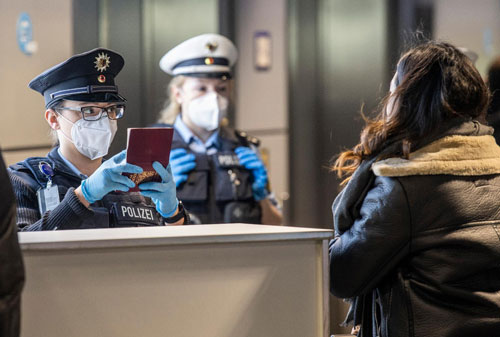Washington
Border restrictions were being tightened around the world Monday in the face of an unrelenting coronavirus threat, after a weekend in which anger at social distancing rules bubbled over into fiery clashes in the Netherlands.
The United States was set to join France, Israel and Sweden in pulling up the drawbridge to certain arrivals, with special concern about new strains of the pathogen that originated in Britain and South Africa.
“When I arrive in a country, the idea is not to contaminate it,” Antoine, an 18-year-old Belgian, told AFP at Paris’s main international airport after new rules on tests for EU arrivals came into force.
“It’s up to us to show that we are civic-minded,” said Spaniard Claudio Barraza.
The stipulations came as Mexico’s President Andres Manuel Lopez Obrador became the latest public figure to test positive for the disease, and New Zealand reported its first community case for more than two months.
In Washington, President Joe Biden will on Monday reimpose a ban on most non-US citizens who have been in Britain, Brazil, Ireland and much on Europe, as well as adding South Africa to the list, a senior White House official said.
The European Union’s executive body proposed Monday that the bloc’s 27 nations impose more travel restrictions to counter the worrying spread of new coronavirus variants but make sure to keep goods and workers moving across EU borders.
Amid concerns related to the production and delivery of Covid-19 vaccines, the European Commission urged EU nations to reinforce testing and quarantine measures for travelers as virus mutations that are more transmissible threaten to overwhelm European hospitals with new cases.
More than 400,000 EU citizens have already died from the virus since the pandemic first hit Europe last year.
“The start of the EU vaccination campaign kicked off the beginning of the end of the pandemic,” EU Justice commissioner Didier Reynders said. “At the same time, new, more transmissible variants of the virus have surfaced. There is currently a very high number of new infections across many member states. And there is an urgent need to reduce the risk of travel-related infections to lessen the burden on overstretched healthcare systems.”
Among the new measures, which need to be approved by EU nations before taking effect, is the addition of a new “dark red” color to the EU’s weekly map of infections.
Reynders said this new color highlights areas where the rate of new confirmed infections in the last 14 days is 500 or more per 100,000 inhabitants. He said between 10 and 20 EU countries would already see that color on all or part of their territory if it was in effect now.
“We also think it is necessary for essential travelers arriving from dark red areas to get tested before traveling and to undergo quarantine, unless these measures would have a disproportionate impact on the exercise of their essential function,” Reynders said.
Since the discovery of the new virus variants, several EU countries have already reinforced their lockdown measures. Belgium has introduced a ban on all nonessential travels for its residents until March, while France could soon start a third lockdown if a stringent 12-hour daily curfew already in place can’t slow down the spread of new infections.
“We are suggesting stricter measures for dark red areas, because we must recognize the high level of cases,” Reynders said.—AFP








